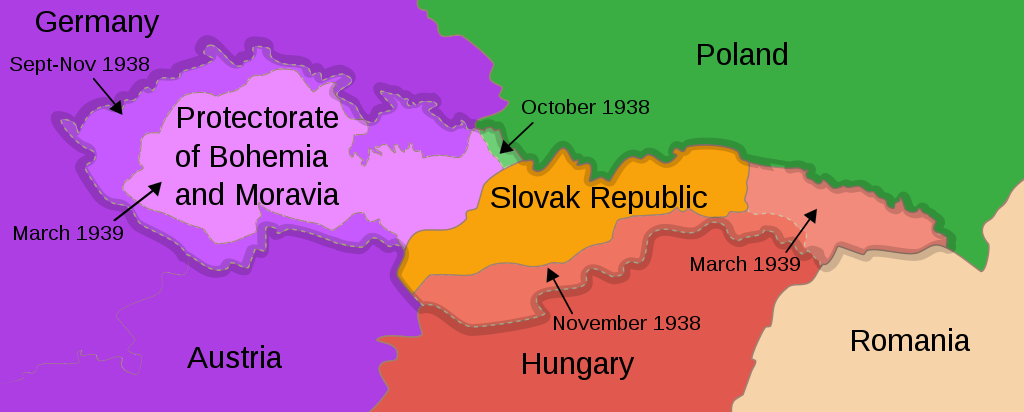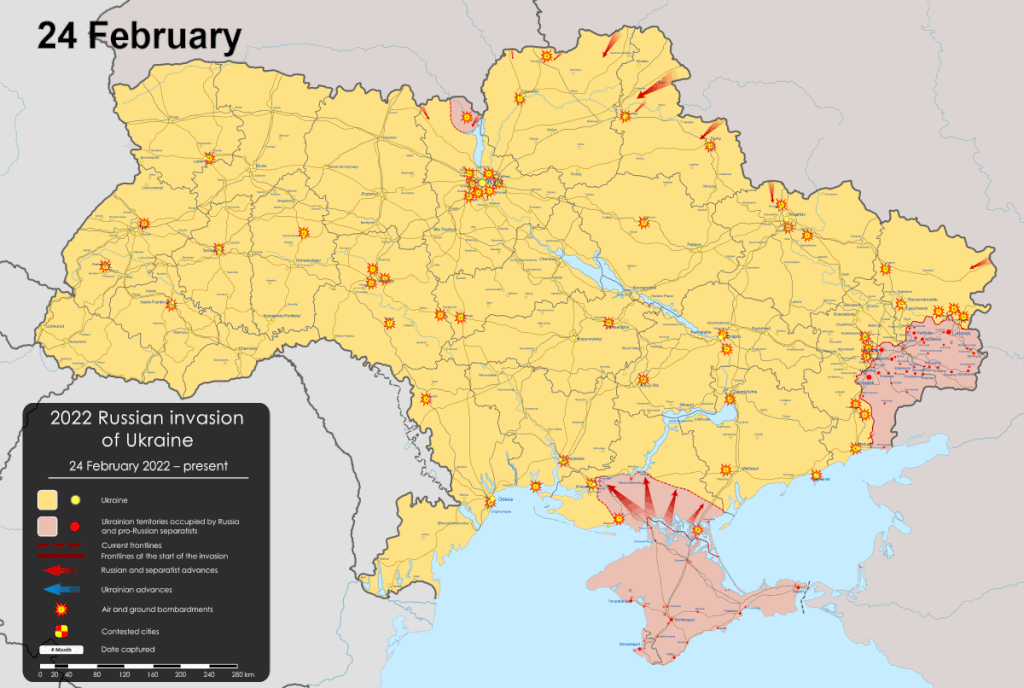“The word ‘appeasement’ is not popular, but appeasement has its place in all policy. Make sure you put it in its place.” - Winston Churchill, 1950
What is appeasement? When is appeasement the right approach - and when is it the wrong approach? Is appeasement a historical relic, or does it still happen today?
We’ll start this discussion with the most famous example of appeasement, then discuss the game of chicken, and then apply the logic of appeasement to present-day problems.
Appeasing Hitler
The most famous example of appeasement in foreign policy comes in the lead-up to World War II. In March of 1938, after four years of violent terrorism by Nazi agents, the army of the Third Reich marched into Austria unopposed. A sham referendum was then conducted on the annexation, with voters required to fill out their ballots in front of loyal armed Nazi soldiers. From September of 1938 to March of 1939, the Nazis continued this process with the annexation of half of what was then Czechoslovakia.1
The annexation of Austria set the stage for the annexation of the Sudetenland both politically and logistically. The Sudetenland (annexed from September to November) consisted of the nearest border regions of Czechoslovakia. The rump state of Bohemia and Moravia was almost completely surrounded by Nazi Germany, and then annexed several months later.

These annexations made the Nazis stronger in three ways:
They gained the economic resources of their new subject territories.
They gained access to additional subject populations that could be conscripted.
This created an “axis” that split Europe in two geographically with Nazis and their allies in the middle.
Appeasement gave the Nazis a southern border with their ally Italy, an eastern border with a newly-formed client state (the Slovak Republic), and an eastern border with their ally Hungary. It increased their manpower and economic resources. It even gave the Nazi military much-needed practical experience with the deployment of troops and resources into foreign territory.
The fact that the Allied powers simply stood back and allowed Hitler to expand his empire in 1938 set the stage for the invasion of Poland in 1939; the inaction of Britain and France during the “Phoney War” of 1939, in turn, set the stage for the successful invasion of France in 1940.2 Appeasing Hitler was unequivocally a strategic mistake.
The game of chicken
The game of “chicken” is easy to describe: Two cars drive directly at each other. The driver who swerves first loses. If neither driver swerves, the result is a devastating head-on collision.
In game theory, this is generalized as the “hawk-dove” game and applies very neatly to the problem of foreign relations. Two players may each choose either war (“hawk”) or peace (“dove”). If both players choose peace (“dove”), nothing happens. If one player chooses war and the other player chooses peace, the player choosing war gets to steal a prize from the other. If both players choose war, both pay a substantial cost that outweighs any expected gains from the conflict.
As a model of military conflict, the game of chicken is wrong but useful. There are many intermediate gradations between total war and total pacifism. Real-world scenarios are rarely symmetric. The actors involved usually have a long series of decision points at which they can de-escalate the conflict. However, as a general rule, the decision-making logic tends to carry over between the game of chicken and the waging of war: War is immensely destructive.
For France and Britain, the immediate cost of Austrian annexation in 1938 was far less than the cost of waging a war against Germany in 1938. On the surface, allowing Nazi Germany to expand into Austria seemed strategically sound to many contemporary leaders: For France and Britain, Hitler governing Austria cost less than having a war.
The repeated game
The potential danger of appeasement is a long-term problem. While it is rational in the moment to chicken out rather than risk a costly conflict, what happens next? Appeasing Hitler in 1938 increased his capacity for waging war in 1939. This is a vicious cycle.
The two key factors that can make appeasement irrational are as follows:
The actor has further ambitions.
Appeasement increases the actor’s capacity to initiate another conflict.
A case study in appeasement
Crimea In 2014, Russian troops invaded Crimea, seizing control of the state legislature and forcing it to vote for the dissolution of the current Crimean government, the installation of a Russia-friendly politician who had won 4% in the previous election in leadership, and scheduling a referendum on the status of Crimea.
Vladimir Putin and Russian nationalists have repeatedly overtly called for the dissolution of Ukraine and the annexation of Ukraine into Russia. The invasion and annexation of Crimea in 2014 faced almost no forceful resistance either from Ukraine or from the international community.3 Materially, this was very similar to the annexation of Austria by Hitler.4
As with the annexation of Austria, the annexation of Crimea set the stage for what happened next, both in the very near term in the Donbass region in 2014 and subsequently in 2022.

The annexation of Crimea also set the stage for Russia’s subsequent multi-front invasion of Ukraine in 2022. Crimea is highly strategically located, and the southern (Crimean) front was the area in which Russian invaders saw the most success, including large portions of Kherson and Zaporizhya as well as the southwestern portion of Donetsk.
Since holding additional territory will make subsequent invasions easier, and since the scope of Russian annexation ambitions very transparently and overtly include substantial additional territory, any peace settlement that cedes Russia ownership of Ukrainian territory can be expected to fuel another vicious cycle of Russian aggression against Ukraine.
Can appeasement work?
To appease literally means to make concessions - to give up something to the other side. In 1998, after about three decades of terrorism and violence, the governments of Ireland and the United Kingdom signed an agreement with multiple political factions within Northern Ireland, including paramilitary groups.
Was this appeasement? The UK made permanent political concessions related to the governance of Northern Ireland in response to roughly thirty years of political violence.5 An exchange of concessions in response to the threat or application of violence could be considered appeasement.
However, the cause of Irish unification is sharply limited in scope. There was never any realistic chance that Irish unification would lead to the invasion of England (or Scotland or Wales). Nor did the Good Friday Agreement increase the IRA’s capacity for violence. It did not provide militants with new bomb-making opportunities.
This is because the Good Friday Agreement was not simply a unilateral set of concessions on the part of the United Kingdom offered in hopes of a change in attitude on the part of pro-unification paramilitary groups. It was a quid pro quo: Inclusion in a nonviolent political process in exchange for a reduction in capacity for violence.
The logic of appeasement
Appeasement is often logical when we consider the short-term perspective. And, in many cases, it makes sense to make some political concessions in exchange for peace. However, it’s important to consider the long-term goals of both parties, and to consider whether or not a violent actor is being rewarded in a way that increases their capacity for future violence.
This is what happened before World War II; it has also been happening with Russia in my lifetime. Appeasing violent aggressors bent on conquest is a bad idea because it fuels a vicious cycle.
The portion annexed during this period corresponds roughly to modern-day Czechia.
We can extend this further to say that the failure of Britain and France to intervene more aggressively during the invasion of Poland - a period known sometimes as the “Phoney War”
The subsequent invasion of eastern Ukraine in 2014 did face resistance from the Ukrainian military.
Including a sham referendum carried out at gunpoint to ratify the annexation, the presence of a minority of the population friendly to the cause, and mass population transfers afterward.
The Troubles of 1966-1998 resulted in about 100 deaths per year. It must be granted that this was a far less intense level of violence than seen in the 1910s-1920s. To place the Troubles in a quantitative US context: During the same period, Detroit averaged around 500 murders per year. Northern Ireland and Detroit had about the same population in 1960, with Detroit’s population declining later in this period.






